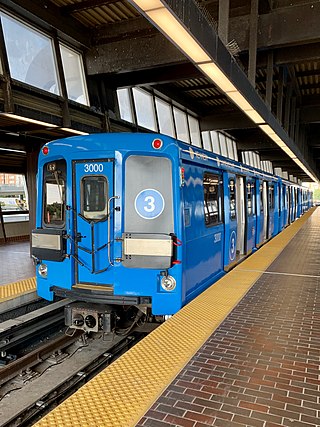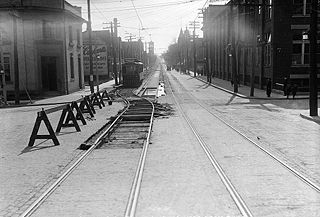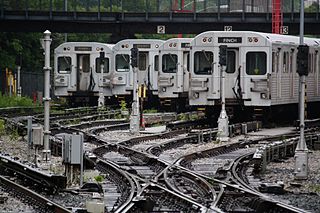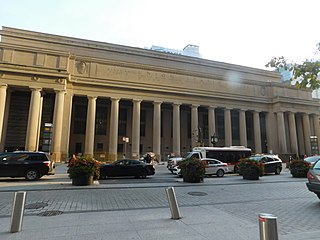
The Toronto Transit Commission (TTC) is the public transport agency that operates bus, subway, streetcar, and paratransit services in Toronto, Ontario, Canada, some of which run into the Peel Region and York Region. It is the oldest and largest of the urban transit service providers in the Greater Toronto Area, with numerous connections to systems serving its surrounding municipalities.

Line 3 Scarborough, originally known as Scarborough RT (SRT), was a light rapid transit line that was part of the Toronto subway system in Toronto, Ontario, Canada. The line ran entirely within the eastern district of Scarborough, encompassing six stations and 6.4 kilometres (4.0 mi) of mostly elevated track. It connected with Line 2 Bloor–Danforth at its southwestern terminus, Kennedy, and terminated in the northeast at McCowan. In 2022, the system had a ridership of 4,720,000, or about 12,300 per weekday as of the third quarter of 2023.

Innovia Metro is an automated rapid transit system manufactured by Alstom. Innovia Metro systems run on conventional metal rails and pull power from a third rail but are powered by a linear induction motor that provides traction by using magnetic force to pull on a "fourth rail" placed between the running rails. However, newer versions of the technology are available with standard electric rotary propulsion.

The Detroit People Mover (DPM) is a 2.94-mile (4.73 km) elevated automated people mover system in Detroit, Michigan, United States. The system operates in a one-way loop on a single track encircling downtown Detroit, using Intermediate Capacity Transit System linear induction motor technology developed by the Urban Transportation Development Corporation. In 2022, the system had a ridership of 364,300, or about 1,900 per weekday as of the third quarter of 2023.

The Toronto subway is a rapid transit system serving Toronto and the neighbouring city of Vaughan in Ontario, Canada, operated by the Toronto Transit Commission (TTC). As of September 2023, the subway system is a rail network consisting of three heavy-capacity rail lines operating predominantly underground. As of December 2022, three new lines are under construction: two light rail lines and one light metro line.

Line 2 Bloor–Danforth is a subway line in the Toronto subway system, operated by the Toronto Transit Commission (TTC). It has 31 stations and is 26.2 kilometres (16.3 mi) in length. It opened on February 26, 1966, and extensions at both ends were completed in 1968 and again in 1980.

Kennedy is the eastern terminal station on Line 2 Bloor–Danforth of the Toronto subway system. Opened in 1980, it is located east of the Kennedy Road and Eglinton Avenue intersection. With the adjacent Kennedy GO station on the Stouffville line of GO Transit, Kennedy is an intermodal transit hub and the fifth busiest station in the system, after Bloor–Yonge, St. George, Sheppard–Yonge, and Union, serving a total of approximately 113,961 customer trips a day.

Ellesmere was a rapid transit station on Line 3 Scarborough of the Toronto subway in Toronto, Ontario, Canada. It was located at Ellesmere Road, between Kennedy Road and Midland Avenue.

Scarborough Centre is a bus terminal in Toronto, Ontario, Canada, serving multiple bus routes of the Toronto Transit Commission (TTC) and one Durham Regional Transit (DRT) bus route. It was also a rapid transit station serving Line 3 Scarborough of the Toronto subway system until Line 3's closure on July 24, 2023. It is located north of Ellesmere Road between Brimley and McCowan Roads, just south of Highway 401. It was adjacent to the former Scarborough Centre Bus Terminal, which was a station for GO Transit buses and other intercity coach services until the TTC modified the facility for TTC buses.

McCowan was a terminal station on Line 3 Scarborough of the Toronto subway. The closed station is located at 1275 McCowan Road, just north of Ellesmere Road at Bushby Drive/Town Centre Court.

Kipling is the western terminus station of Line 2 Bloor–Danforth of the Toronto subway system. The station is served by buses and subway trains operated by the Toronto Transit Commission and is adjacent to the Kipling GO Station on the Milton line of GO Transit and the Kipling Bus Terminal, where passengers can connect with MiWay and GO Transit bus services. It is located in the Islington–City Centre West neighbourhood on St. Albans Road at Aukland Road, west of the overpass of Kipling Avenue, after which the station is named. The 900 Airport Express bus route connects Kipling to the Toronto Pearson International Airport.

The history of public transportation in Toronto in Canada dates back to the middle 19th century under many different private companies, organizations and owners, which were all later unified as a single government-run entity during the 1920s.

The Urban Transportation Development Corporation Ltd. (UTDC) was a Crown corporation owned by the Government of Ontario, Canada. It was established in the 1970s as a way to enter what was then expected to be a burgeoning market in advanced light rail mass transit systems. It developed significant expertise in linear propulsion, steerable trucks and driverless system controls which were integrated into a transit system known as the Intermediate Capacity Transit System (ICTS). It was designed to provide service at rider levels between a traditional subway on the upper end and buses and streetcars on the lower, filling a niche aimed at suburbs that were otherwise expensive to service.

The H series was the third series of rapid transit rolling stock used in the subway system of Toronto, Ontario, Canada. They were built in six production sets, named H-1 to H-6, from 1965 to 1990 in Thunder Bay, Ontario, for the Toronto Transit Commission (TTC).

The G series was the first rolling stock of rapid transit cars used on the Toronto subway, built 1953–1959 by the Gloucester Railway Carriage and Wagon Company of Gloucester, England, for the Toronto Transit Commission (TTC) of Toronto, Canada.
Accessibility for people with disabilities on the Toronto Transit Commission (TTC) system is incomplete but improving. Most of the Toronto subway system was built before wheelchair access was a requirement under the Ontarians with Disabilities Act (ODA). However, all subway stations built since 1996 are equipped with elevators, and elevators have been installed in 44 stations built before 1996. Over 75 percent of Toronto's subway stations are accessible. The original plan was to make all stations accessible by 2025; however, a few stations might not be accessible until 2026.

The Toronto subway system's rolling stock consists of 880 subway cars for Line 1 Yonge–University, Line 2 Bloor–Danforth, and Line 4 Sheppard. The rolling stock is owned and maintained by the Toronto Transit Commission (TTC).

The Toronto Rocket (TR) is the fifth and latest series of rolling stock used in the Toronto subway system in Toronto, Ontario, Canada. Owned and operated by the Toronto Transit Commission (TTC), the trains were built by Bombardier Transportation in Thunder Bay, Ontario, to replace the last remaining H-series trains, as well as increase capacity for the Spadina subway extension to Vaughan that opened in 2017. They operate in a six-car configuration on Line 1 Yonge–University and a four-car configuration on Line 4 Sheppard. The sets are stored and maintained at the Wilson and Davisville Yards. The first six-car TR train entered passenger service on Line 1 in July 2011, and four-car TR trainsets entered service on Line 4 in May 2016.
Thales Rail Signalling Solutions is a division of Thales Group that supplies transportation-based automation solutions for railways. Its operations are controlled from several locations:

Public transportation in the Canadian city of Toronto dates back to 1849 with the creation of a horse-drawn stagecoach company. Today, Toronto's mass transit is primarily made up of a system of subways, buses, and streetcars, covering approximately 1,200 km (750 mi) of routes operated by the Toronto Transit Commission (TTC) and inter-regional commuter rail and bus service provided by GO Transit.




























